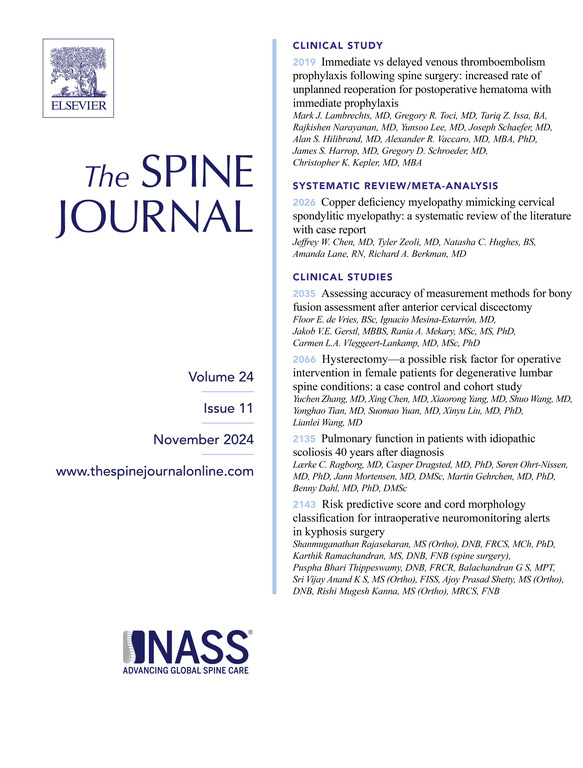衰老剂鸡尾酒达沙替尼和槲皮素可缓解小鼠软骨细胞衰老和面关节骨关节炎。
IF 4.7
1区 医学
Q1 CLINICAL NEUROLOGY
引用次数: 0
摘要
背景情况:腰背痛(LBP)是一个普遍存在的问题,在全球范围内造成了巨大的经济负担和身体痛苦。面关节骨关节炎(FJ OA)被认为是造成这一问题的重要原因。目的:本研究旨在了解达沙替尼(D)和槲皮素(Q)作为一种治疗方法在FJ OA进展过程中清除软骨细胞衰老的潜力:研究设计:我们采用临床前双足站立小鼠模型,在小鼠双足站立10周后给予达沙替尼(D)(5 mg/kg)和槲皮素(Q)(50 mg/kg)。材料与方法:我们获得了人类退行性腰椎面关节(LFJ)样本,以研究软骨细胞衰老与LFJ骨关节炎(OA)之间的关系。随后,我们建立了软骨细胞过度机械应力体外模型和体内双足站立小鼠模型,以诱导 LFJ OA。应用体内 IHC(免疫组化)染色、SA-β-gal 染色、qRT-PCR 和 Western 印迹分析来检验达沙替尼(D)和槲皮素(Q)联合应用的衰老作用。此外,还通过IHC染色和X射线显微镜检查了D+Q对软骨和软骨下骨再结合中合成代谢的贡献。在体外进行免疫荧光和 Western 印迹分析,在体内进行 IHC 染色,以评估 D+Q 对软骨细胞衰老过程中 NF-κB 通路激活调控的影响:结果:我们观察到,在人类和小鼠退行性样本中,面关节软骨退变与软骨细胞衰老有关。在体外用 D+Q 处理后,细胞衰老明显减少。在双足站立小鼠模型中口服 D+Q 后,观察到细胞衰老减少,软骨细胞合成代谢逆转。此外,D+Q还能维持软骨下骨重塑的平衡,并有可能逆转腰椎关节软骨细胞中NF-κB通路的激活:总之,我们的研究揭示了软骨细胞衰老与 LFJOA 之间的显著相关性。在 FJ OA 中使用 D+Q 组合溶解剂治疗可显著减少软骨细胞的衰老,同时减少 SASP 因子的释放。此外,它还有助于促进软骨合成代谢、维持软骨下骨耦合以及改善 NF-κB 通路的激活:临床意义:我们的研究结果表明,D+Q这种著名的解痉治疗组合能缓解LFJ OA的恶化。D+Q作为一种解毒剂,为LFJ OA的治疗提供了一种新颖而有前景的选择。本文章由计算机程序翻译,如有差异,请以英文原文为准。

Senolytics cocktail dasatinib and quercetin alleviate chondrocyte senescence and facet joint osteoarthritis in mice
BACKGROUND CONTEXT
Low back pain (LBP) is a pervasive issue, causing substantial economic burden and physical distress worldwide. Facet joint osteoarthritis (FJ OA) is believed to be a significant contributor to this problem. However, the precise role of chondrocyte senescence in FJ OA remains unclear, as does whether the clearance of chondrocyte senescence can alleviate the progression of FJ OA.
PURPOSE
The goal of this study was to understand the potential of Dasatinib (D) and Quercetin (Q) as a treatment to clear chondrocyte senescence during the progression of FJ OA.
STUDY DESIGN
We used a preclinical bipedal standing mice model with the administration of Dasatinib (D) (5 mg/kg) and Quercetin (Q) (50 mg/kg) after 10 weeks of bipedal standing.
MATERIALS AND METHODS
Human degenerative lumbar facet joint (LFJ) samples were obtained to investigate the relationship between chondrocyte cellular senescence and LFJ osteoarthritis (OA). Subsequently, we established an in vitro model of excessive mechanical stress on chondrocytes and an in vivo bipedal standing mice model to induce LFJ OA. IHC (immunohistochemistry) staining in vivo and SA-β-gal staining, qRT-PCR and Western blot analysis were applied to test the senolytic effect of the combination of Dasatinib (D) and Quercetin (Q). IHC staining and X-ray microscope were also performed to examine the contribution of D+Q to the anabolism in cartilage and subchondral bone recoupling. Immunofluorescence and Western blot analysis in vitro and IHC staining in vivo were conducted to assess the impact of D+Q on the regulation of the NF-κB pathway activation during chondrocyte senescence.
RESULTS
We observed that facet joint cartilage degeneration is associated with chondrocyte cellular senescence in both human and mouse degenerative samples. Following treatment with D+Q in vitro, cellular senescence was significantly reduced. Upon oral gavage administration of D+Q in the bipedal standing mice model, decreased cellular senescence and reversed chondrocyte anabolism were observed. Furthermore, administration of D+Q maintained subchondral bone remodeling homeostasis and potentially reversed the activation of the NF-κB pathway in chondrocytes of the lumbar facet joint.
CONCLUSIONS
In summary, our investigation unveiled a significant correlation between chondrocyte senescence and LFJOA. Treatment with the senolytic combination of D+Q in FJ OA yielded a notable reduction in chondrocyte senescence, along with a decrease in the release of SASP factors. Additionally, it facilitated the promotion of cartilage anabolism, maintenance of subchondral bone coupling, and amelioration of NF-κB pathway activation.
CLINICAL SIGNIFICANCE
Our outcomes revealed that D+Q, the renowned combination used for senolytic treatment, alleviate the progression of LFJ OA. The utilization of D+Q as a senolytic demonstrates a novel and promising alternative for LFJ OA treatment.
求助全文
通过发布文献求助,成功后即可免费获取论文全文。
去求助
来源期刊

Spine Journal
医学-临床神经学
CiteScore
8.20
自引率
6.70%
发文量
680
审稿时长
13.1 weeks
期刊介绍:
The Spine Journal, the official journal of the North American Spine Society, is an international and multidisciplinary journal that publishes original, peer-reviewed articles on research and treatment related to the spine and spine care, including basic science and clinical investigations. It is a condition of publication that manuscripts submitted to The Spine Journal have not been published, and will not be simultaneously submitted or published elsewhere. The Spine Journal also publishes major reviews of specific topics by acknowledged authorities, technical notes, teaching editorials, and other special features, Letters to the Editor-in-Chief are encouraged.
 求助内容:
求助内容: 应助结果提醒方式:
应助结果提醒方式:


